高职高考英语语法专题一: 名词课件(33张PPT)
文档属性
| 名称 | 高职高考英语语法专题一: 名词课件(33张PPT) |  | |
| 格式 | zip | ||
| 文件大小 | 356.7KB | ||
| 资源类型 | 教案 | ||
| 版本资源 | 其它版本 | ||
| 科目 | 英语 | ||
| 更新时间 | 2021-07-01 17:40:31 | ||
图片预览

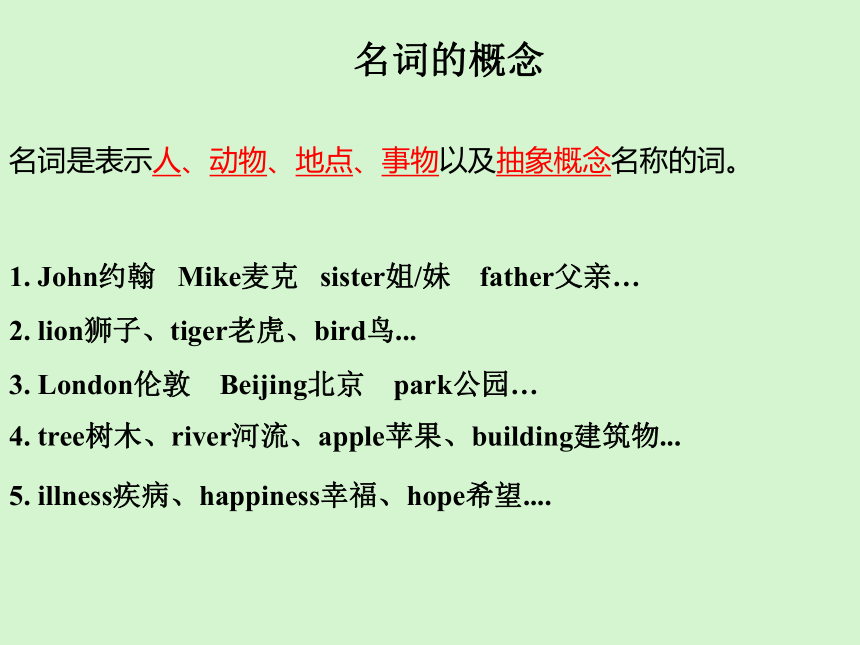
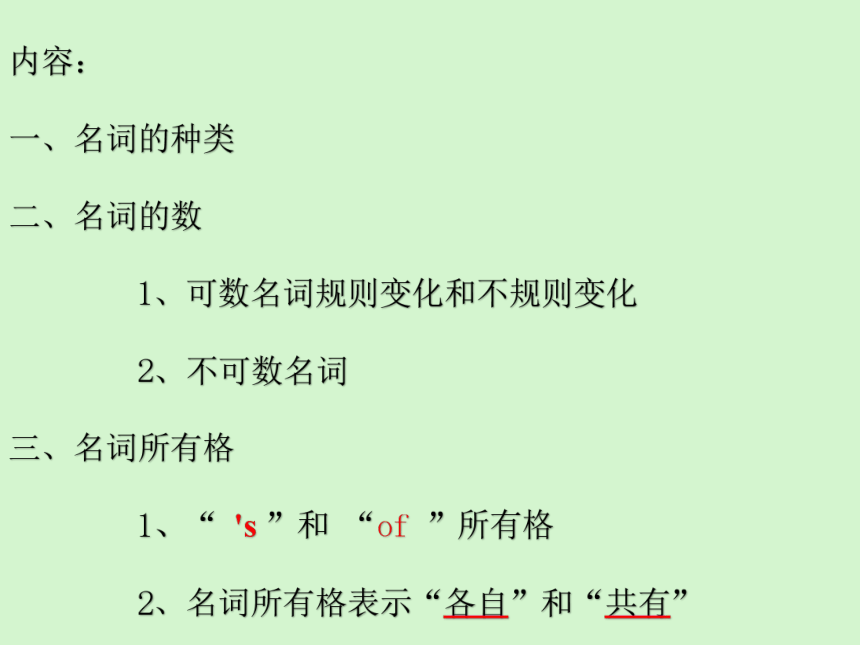
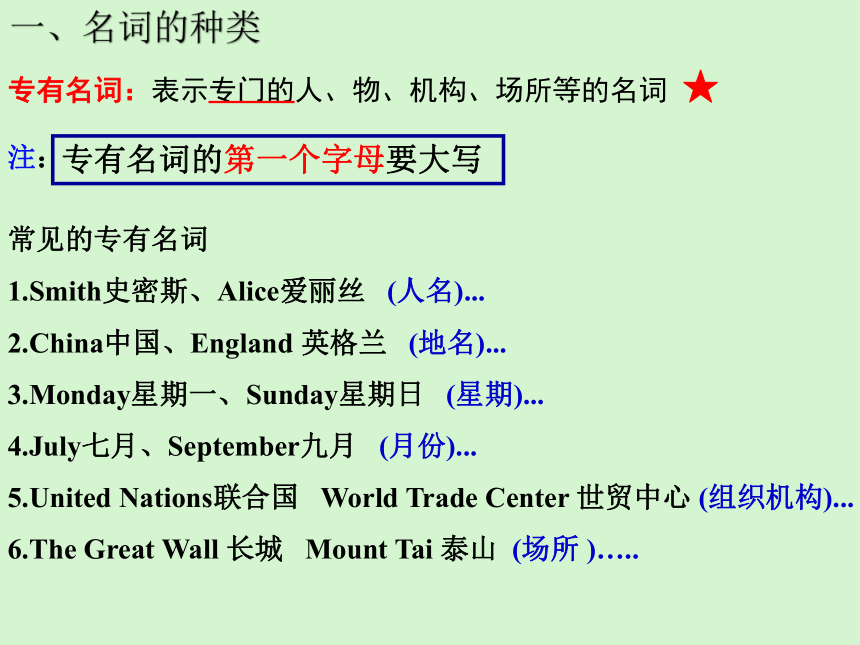
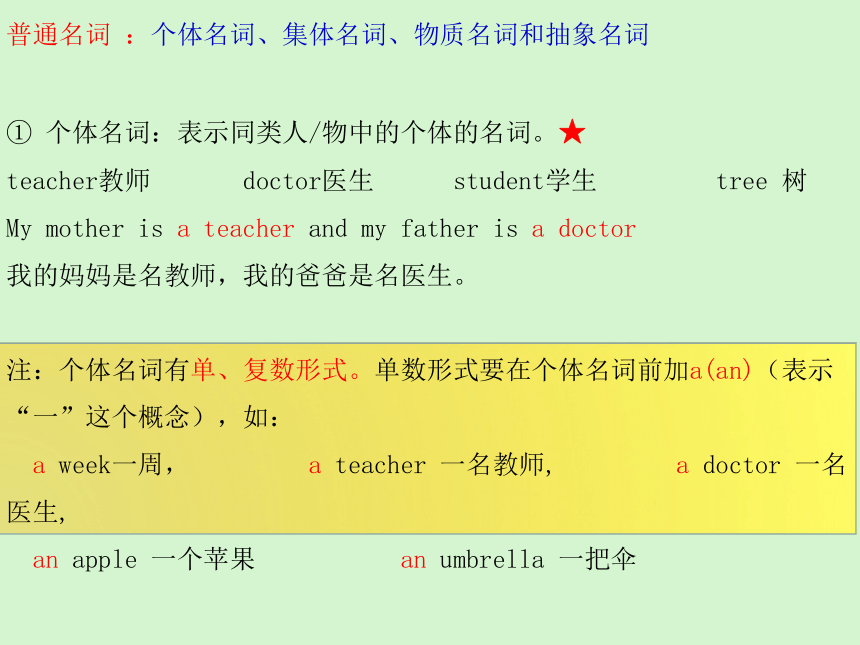
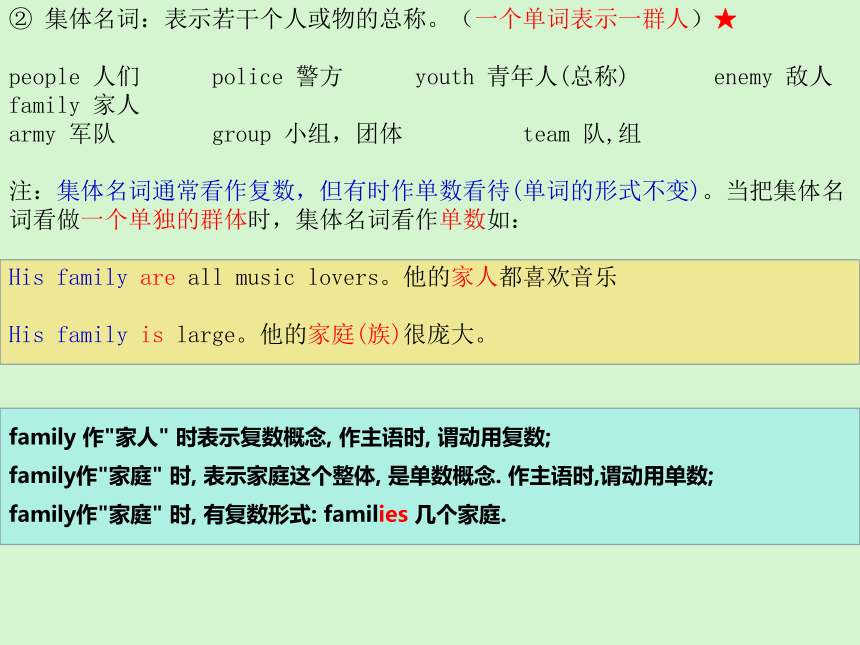

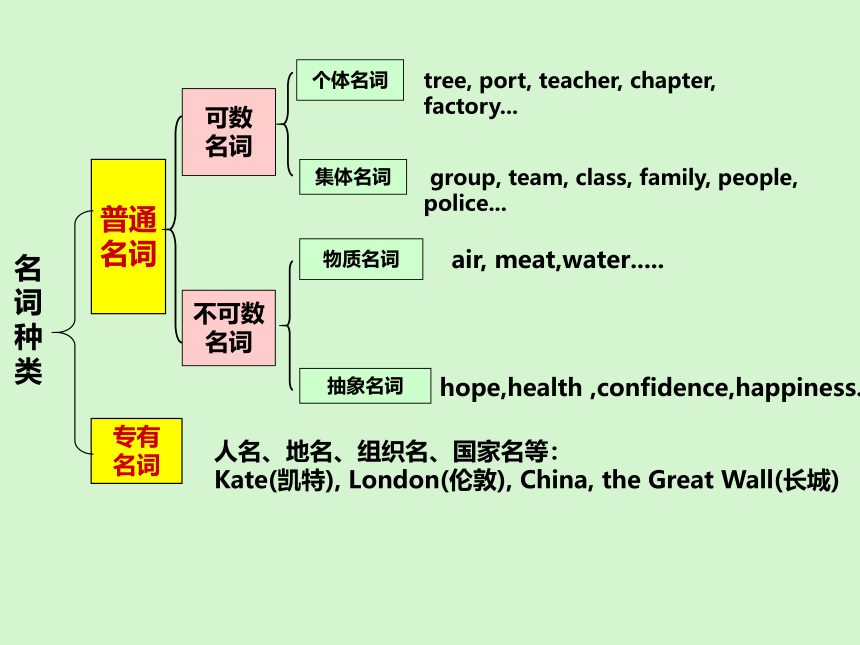
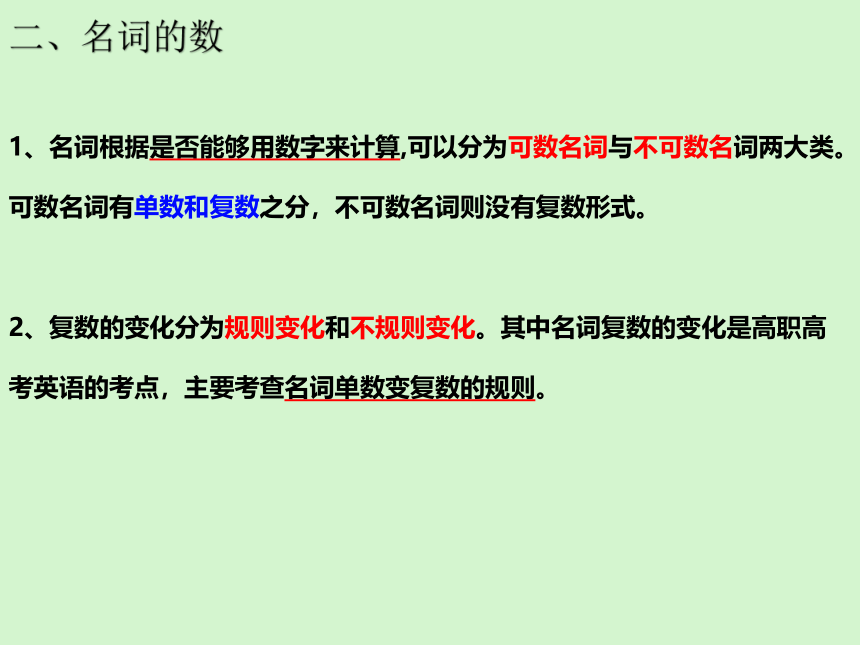
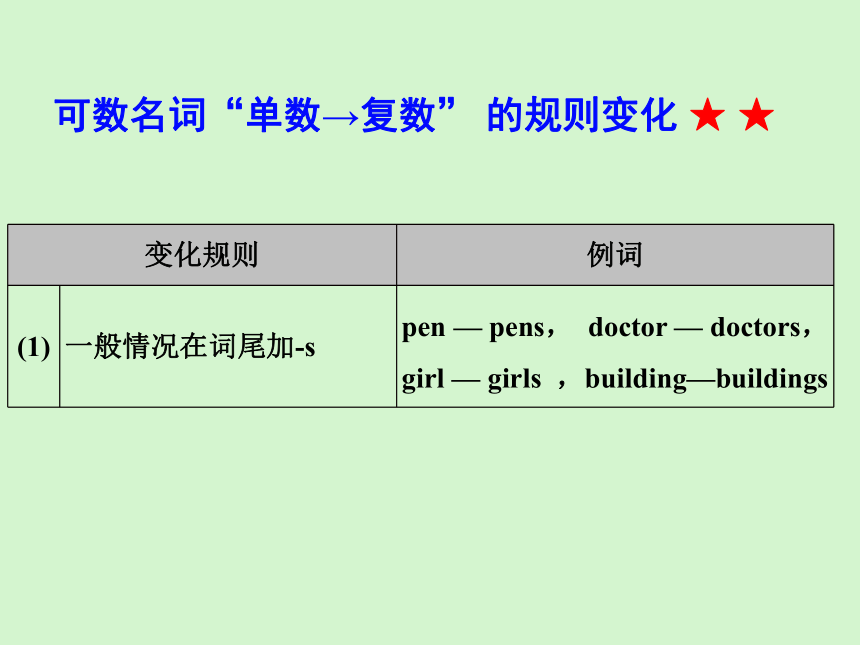

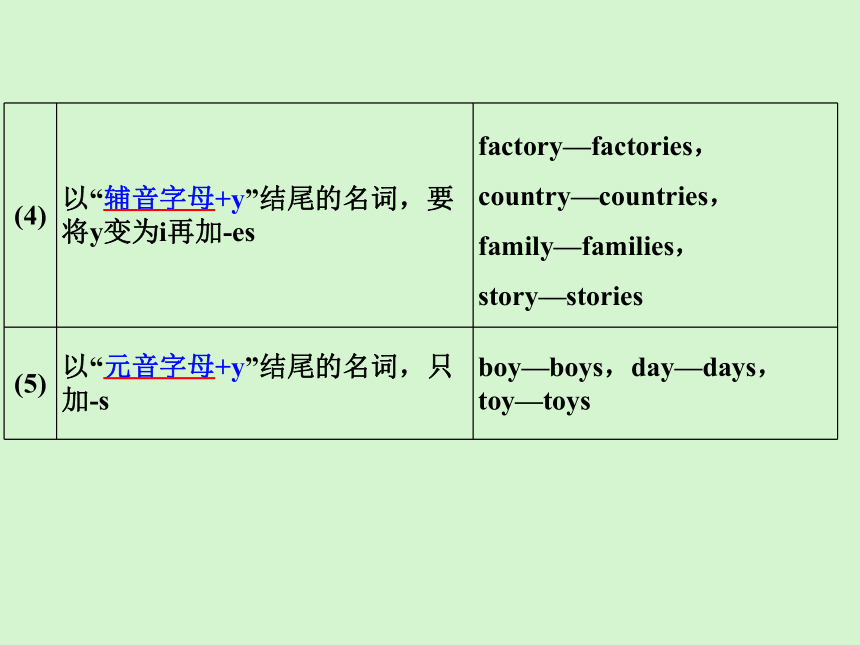
文档简介
(共33张PPT)
专题一
名词
高职高考语法专题知识归纳
名词的概念
名词是表示人、动物、地点、事物以及抽象概念名称的词。
1.
John约翰
Mike麦克
sister姐/妹
father父亲…
2.
lion狮子、tiger老虎、bird鸟...
3.
London伦敦
Beijing北京
park公园…
4.
tree树木、river河流、apple苹果、building建筑物...
5.
illness疾病、happiness幸福、hope希望....
内容:
一、名词的种类
二、名词的数
1、可数名词规则变化和不规则变化
2、不可数名词
三、名词所有格
1、“
's
”和
“of
”所有格
2、名词所有格表示“各自”和“共有”
一、名词的种类
专有名词:表示专门的人、物、机构、场所等的名词
★
注:
常见的专有名词
1.Smith史密斯、Alice爱丽丝
(人名)...
2.China中国、England
英格兰
(地名)...
3.Monday星期一、Sunday星期日
(星期)...
4.July七月、September九月
(月份)...
5.United
Nations联合国
World
Trade
Center
世贸中心
(组织机构)...
6.The
Great
Wall
长城
Mount
Tai
泰山
(场所
)…..
专有名词的第一个字母要大写
普通名词
:个体名词、集体名词、物质名词和抽象名词
①
个体名词:表示同类人/物中的个体的名词。★
teacher教师
doctor医生
student学生
tree
树
My
mother
is
a
teacher
and
my
father
is
a
doctor
我的妈妈是名教师,我的爸爸是名医生。
注:个体名词有单、复数形式。单数形式要在个体名词前加a(an)(表示“一”这个概念),如:
a
week一周,
a
teacher
一名教师,
a
doctor
一名医生,
an
apple
一个苹果
an
umbrella
一把伞
②
集体名词:表示若干个人或物的总称。(一个单词表示一群人)★
people
人们
police
警方
youth
青年人(总称)
enemy
敌人
family
家人
army
军队
group
小组,团体
team
队,组
注:集体名词通常看作复数,但有时作单数看待(单词的形式不变)。当把集体名词看做一个单独的群体时,集体名词看作单数如:
His
family
are
all
music
lovers。他的家人都喜欢音乐
His
family
is
large。他的家庭(族)很庞大。
family
作"家人"
时表示复数概念,
作主语时,
谓动用复数;
family作"家庭"
时,
表示家庭这个整体,
是单数概念.
作主语时,谓动用单数;
family作"家庭"
时,
有复数形式:
families
几个家庭.
③
物质名词:物质和材料的总称,表示材料液体、气体、食物、饮料等的名词。
(表示无法分为个体的物质或实物)★
sand沙子
ink墨水油
wood木材
water水
cloth衣服
ice冰
tea茶
注:除了一些特殊情况,大多数物质名词是不可数的,因而没有复数形式。
④
抽象名词:表示动作、性质、状态、情感等抽象概念的名词。age年龄
★
death死亡
birth
出生
strength力量
happiness幸福
health健康
注:在多数情况下,这些名词多用于单数形式,不加任何冠词
名词
种类
普通
名词
tree,
port,
teacher,
chapter,
factory...
不可数
名词
可数
名词
group,
team,
class,
family,
people,
police...
人名、地名、组织名、国家名等:
Kate(凯特),
London(伦敦),
China,
the
Great
Wall(长城)
专有
名词
个体名词
抽象名词
集体名词
air,
meat,water.....
hope,health
,confidence,happiness...
物质名词
二、名词的数
1、名词根据是否能够用数字来计算,可以分为可数名词与不可数名词两大类。可数名词有单数和复数之分,不可数名词则没有复数形式。
2、复数的变化分为规则变化和不规则变化。其中名词复数的变化是高职高考英语的考点,主要考查名词单数变复数的规则。
可数名词“单数→复数”
的规则变化
★
★
变化规则
例词
(1)
一般情况在词尾加?s
pen
—
pens,
doctor
—
doctors,girl
—
girls
,building—buildings
(2)
在以?s,?sh,?ch,?x结尾的名词后面加?es
bus—buses,dish—dishes,box—boxes
,church—churches
stomach—stomachs(胃)
(3)
以?f或?fe结尾的名词
将?f或?fe变为v再加?es
knife—knives,leaf—leaves,wolf—wolves
直接加?s
roof—roofs
,
gulf—gulfs,
belief
—
beliefs,
giraffe—giraffes
(4)
以“辅音字母+y”结尾的名词,要将y变为i再加?es
factory—factories,country—countries,family—families,
story—stories
(5)
以“元音字母+y”结尾的名词,只加?s
boy—boys,day—days,toy—toys
(6)
以字母-o结尾的名词
表示有生命的词在词尾加-es
(常见4个)
(西土英黑)
tomato—tomatoes,
potato—potatoes,
hero—heroes,
negro—negroes
(黑人)
表示无生命的词在词尾加-s
piano—pianos,photo—photos
radio—radios,
zoo—zoos
bamboo—bamboos(竹子)
【巩固训练】
写出下列可数名词的复数形式
pencil________
window________
leaf______
wolf_______
box_______
glass______?
?
church______
fish_____
boy______
lady______
bamboo______
hero________
总结规律:
1、看名词的词尾;
2、-y结尾名词观察“y”前的字母是元音字母/辅音字母;
3、-o结尾的名词,熟记4个常见加-es,其余均加-s
;
4、记住规则变化中的一些特殊情况
pencils
windows
leaves
wolves
boxes
glasses
churches
fishes
boys
ladies
bamboos
heroes
1.When
we
got
to(到达)
his
room,we
found
three_____
and
two_____.
A.tomatoes
;
radioes
B.tomatos
;
radios
C.tomato
;
radio
D.tomatoes
;
radios
2.Jeams
is
a
____
and
he
has
a
big
_____.
A.farmers
;
farm
B.farmer
;
farms
C.farmers
;
farms
D.farmer
;
farm
总结规律:可数名词有单复数之分:
当可数名词表示单数时(名词前有a/an,one),名词不变复数;
当可数名词表示复数时(名词前有数词且大于一,或者有表示“许多”“一些”等含义的词时),名词变复数。
总结
1、名词根据是否能够用数字来计算分为
______________和______________
2.
可数名词有__________
和____________之分。
①一般可数名词在词尾加________;
②-s、-ch、-sh、-x结尾的,在词尾加
_______;
③字母-o结尾的,__________在词尾加-es,__________在词尾加-s
④一般来说,以-f或-fe结尾的名词,把-f或-fe变为_______,加-es
⑤“辅音+y
”结尾的名词,把-y变为_______
加-es
可数名词“单数→复数”
的不规则变化
★
★
变现形式
例词
(1)
改“a”为“e”
man-men,
woman-women,
policeman-policemen….
【German-Germans
德国人】
(2)
改“oo”为“ee”
foot-feet,
goose-geese(鹅)
tooth-teeth(牙齿)
变现形式
例词
(3)
单复数同形
[两种动物
两种人]
deer-deer(鹿),
sheep-sheep(绵羊)
【a
deer-six
deer,
one
sheep-two
sheep】
Chinese-Chinese,
Japanese-Japanese
a
Chinese-many
Chinese
a
Japanese-ten
Japanese
(4)
复合名词
一般将最后一个名词变复数
apple
tree-apple
trees,
book
store-book
stores
名词前有man/woman时,两个名词都变复数
man
doctor-men
doctors
,
woman
nurse-women
nurses
2.可数名词“单数→复数”
的不规则变化
★
★
2.可数名词“单数→复数”
的不规则变化
★
★
变现形式
例词
(5)
其他特殊变化
child-children(小孩)
mouse-mice(老鼠)
(2)
一些只有复数形式的名词
trousers
裤子
glasses
眼镜
clothes
衣服
chopsticks
筷子
stairs
楼梯
socks
袜子
【巩固训练】
1.There
are
fifteen
________
in
our
school.
They
are
very
kind(和蔼的).
A.woman
teacher
B.women
teacher
C.
woman
teachers
D.
women
teachers
2.He
has
four
________.
All
of
them
can
brush(刷)
their
_______.
A.children
;
tooth
B.children
;
teeth
C.child
;
teeth
D.
child
;
tooth
总结
名词复数的不规则变化
①将“a”改为
_________;
②将“oo”改为
__________;
③单复数同形
_________个;
④两个特殊变化;
⑤一些只有复数的名词
2.不可数名词:表示无法用数字来计算的名词
注意事项:1.它们前面不能加
a/an
2.它们没有复数形式,不能和数词(one、two、three...)连用
3.不能单凭汉语的思维判断某个名词在英语中是否可数。
air
空气、beef
牛肉、bread
面包、chalk
粉笔、coal
煤、coffee
咖啡、cotton
棉花、fish
鱼、food
食物、fruit
水果、hair
头发、health
健康、ice
冰、information
信息、meat
肉、metal
金属、milk
牛奶、money
金钱、
music
音乐、mutton羊肉、news
消息、noise
噪声、orange
桔子汁、
paper
纸、pork
猪肉、rice大米、salt
盐、sand
沙子、silk
丝绸、snow
雪、tea
茶、temperature
温度、time
时间、treasure
金银财宝、water水、weather天气、wind风、wood木头、wool羊毛、work
工作、advice
劝告、knowledge
知识
不可数名词有以下规律:★
①
液体(liquid):water水、coffee咖啡、milk牛奶、orange
juice橙汁、oil油、tea
茶…
②
肉类(meat):
beef牛肉、fish鱼肉、mutton羊肉、pork猪肉、chicken鸡肉
……
③
颗粒物(particle)
:
sand砂、salt盐、sugar糖、rice米饭、coal媒
……
④
气体(gas):
air空气、oxygen氧气
、fog雾、smoke烟....
⑤
面粉/面制品:
flour面粉、wheat小麦、bread面包
……
⑥
其他物质名词:
cotton棉花、food食物
、fruit水果
、ice冰
、money钱
、paper纸
、silk
丝绸、snow雪、wood木材、wool羊毛
⑦
抽象名词(情感、学科、概念):
information信息、music音乐、news新闻
、noise噪音、temperature温度、time时间、weather天气、math数学、advice建议
、knowledge知识、anger愤怒、sadness悲伤….
名词
用作可数
用作不可数
名词
用作可数
用作不可数
paper
试卷,报纸
纸
light
灯
光
glass
玻璃杯
玻璃
room
房间
空间
chicken
小鸡
鸡肉
orange
橘子
橘子汁
time
次数
时间
wood
树林
木材
名词的双重性:有些名词既可作可数名词,也可作不可数名词,但在意义上有所不同。
★
如果不可数名词要表示一定数量,则需要在前面加“量”词
★
★
常见结构:
a
cup
of
tea
一杯茶
a
bottle
of
milk
一瓶牛奶
a
piece
of
paper
一张纸
数词
+
量词
+
of
+
不可数名词
如果数词大于1,那么量词要用复数形式,不可数名词不用变
two
cups
of
tea
两杯茶
three
bottles
of
milk
三瓶牛奶
six
pieces
of
paper
六张纸
【例题】
I’m
so
hungry.
Please
give
me
______
to
eat.
A.
three
bread
B.
three
pieces
of
bread
C.
three
pieces
of
breads
D.
three
piece
of
breads
【巩固练习】
1.Mum,I’m
very
thirsty(口渴).Please
give
me
.
A.two
orange
B.two
bottle
of
oranges
C.two
bottles
of
orange
D.two
bottles
of
oranges
2.
I
paid(支付)
?10
for_______
this
morning.
A.4
bottle
milks
B.4
bottles
of
milk
C.4
bottles
of
milks
D.4
milk
总结
1.不可数名词的分类:液体、肉类、颗粒物、气体、面粉/面制品、抽象名词
2.名词的双重性
——
有些名词既可以作可数名词,也可以作不可数名词,但意义不同。
3.不可数名词要表示一定数量,则需要在前面加“量”词
物质名词
数词
+
量词
+
of
+
不可数名词
三、名词所有格(表示名词与名词之间的所属关系,即“谁归谁所有”)
’s所有格:名词(物主)
+
’s
+
名词(所属)
名词所有格
分类
★
of
所有格:the
+名词(所属)
+
of
+
the
+名词(物主)
例:
Tom’s
computer
汤姆的电脑
The
leg
of
the
desk
桌脚(桌子的脚)
’s所有格的用法(物主的名词放前面,所属物的放后面)
(1)单数名词:在第一个(物主的)名词词尾加
“
’s
”
★
Tom’s
father
汤姆的父亲
the
people’s
choise
人民的选择
(2)复数名词
★
①以-s或-es结尾的复数名词,在第一个(物主的)名词后加
“
’
”
Teachers’
Day
教师节
my
friends’
money
我朋友们的钱
②不以-s或-es结尾的特殊变化的复数名词,在第一个(物主的)名词后加
“
’s
”
Children’s
Day
儿童节
women’s
clothing
女装
③由and连接的两个表示物主的名词,当表示“两人共同拥有”的时,只在最后一个名词词尾加“
’s
”
;
若表示“两人各自所有”,则在每个名词词尾加“
’s
”,同时表示所属物的名词要变复数
★★
如:
Jim
and
Kate’s
room
吉姆和凯特的房间(共有)
Jim’s
and
Kate’s
rooms
吉姆和凯特各自的房间(不共有)
【例题】
Miss
Chen
is
______mother.
A.
Julia
and
Mary
B.
Julia
and
Mary’s
C.
Julia’s
and
Mary’s
D.
Julia’s
and
Mary
④表示时间、距离、国家、城市的名词,也可以用's
所有格。如:
today’s
newspaper
今天的报纸,
an
hour’s
walk/ride
一小时的路程,
the
world's
problem
世界的问题,
two
kilometers’
road
两公里的路,
eight
days'
holiday
八天的假期
这些名词的所有格都表示“…的…(东西)”
of所有格:表示无生命物体的名词的所有关系(所属物的名词放前面,物主放后面)★
the
roof
of
the
church
教堂的屋顶
the
name
of
the
song
歌名
the
name
of
the
book
书名
the
leg
of
the
table桌子腿
【巩固练习】
_______fathers
didn’t
come
to
the
party
yesterday.
A.
Jeff’s
and
Amy’s
B.
Jeff
and
Amy
C.
Jeff’s
and
Amy
D.
Jeff
and
Amy’s
2.
It’s
not
only(不仅仅)
_______
job
to
look
after
children.
A.
women’s
B.
woman’s
C.
women
D.
woman
【综合练习】
1.Can
you
get
on(上车)
the
_____
with
two
big
______.
A.bus
;
box
B.buses
;
box
C.bus
;
boxes
D.buses
;boxes
2.There
are
two
____
and
five
_____in
the
zoo.
A.sheep;deer
B.sheep;tiger
C.bear;deer
D.monkey;tigers
3.I
need
to
write
a
letter(信)
to
my
friends.
I
need
________.
A.a
book
B.an
umbrella(雨伞)
C.a
piece
of
paper
D.a
paper
4.The
two
schoolbags
in
the
classroom
are
_______.
A.Jim
and
Dick
B.Jim’s
and
Dick’s
C.Jim’s
and
Dick
D.Jim
and
Dick’s
5.In
_____newspaper(报纸),there
is
an
story
written
by
______uncle.
A.today
;Tom
B.today’s
;
Tom’s
C.today’s
;
Tom
D.today
;
Tom’s
专题一
名词
高职高考语法专题知识归纳
名词的概念
名词是表示人、动物、地点、事物以及抽象概念名称的词。
1.
John约翰
Mike麦克
sister姐/妹
father父亲…
2.
lion狮子、tiger老虎、bird鸟...
3.
London伦敦
Beijing北京
park公园…
4.
tree树木、river河流、apple苹果、building建筑物...
5.
illness疾病、happiness幸福、hope希望....
内容:
一、名词的种类
二、名词的数
1、可数名词规则变化和不规则变化
2、不可数名词
三、名词所有格
1、“
's
”和
“of
”所有格
2、名词所有格表示“各自”和“共有”
一、名词的种类
专有名词:表示专门的人、物、机构、场所等的名词
★
注:
常见的专有名词
1.Smith史密斯、Alice爱丽丝
(人名)...
2.China中国、England
英格兰
(地名)...
3.Monday星期一、Sunday星期日
(星期)...
4.July七月、September九月
(月份)...
5.United
Nations联合国
World
Trade
Center
世贸中心
(组织机构)...
6.The
Great
Wall
长城
Mount
Tai
泰山
(场所
)…..
专有名词的第一个字母要大写
普通名词
:个体名词、集体名词、物质名词和抽象名词
①
个体名词:表示同类人/物中的个体的名词。★
teacher教师
doctor医生
student学生
tree
树
My
mother
is
a
teacher
and
my
father
is
a
doctor
我的妈妈是名教师,我的爸爸是名医生。
注:个体名词有单、复数形式。单数形式要在个体名词前加a(an)(表示“一”这个概念),如:
a
week一周,
a
teacher
一名教师,
a
doctor
一名医生,
an
apple
一个苹果
an
umbrella
一把伞
②
集体名词:表示若干个人或物的总称。(一个单词表示一群人)★
people
人们
police
警方
youth
青年人(总称)
enemy
敌人
family
家人
army
军队
group
小组,团体
team
队,组
注:集体名词通常看作复数,但有时作单数看待(单词的形式不变)。当把集体名词看做一个单独的群体时,集体名词看作单数如:
His
family
are
all
music
lovers。他的家人都喜欢音乐
His
family
is
large。他的家庭(族)很庞大。
family
作"家人"
时表示复数概念,
作主语时,
谓动用复数;
family作"家庭"
时,
表示家庭这个整体,
是单数概念.
作主语时,谓动用单数;
family作"家庭"
时,
有复数形式:
families
几个家庭.
③
物质名词:物质和材料的总称,表示材料液体、气体、食物、饮料等的名词。
(表示无法分为个体的物质或实物)★
sand沙子
ink墨水油
wood木材
water水
cloth衣服
ice冰
tea茶
注:除了一些特殊情况,大多数物质名词是不可数的,因而没有复数形式。
④
抽象名词:表示动作、性质、状态、情感等抽象概念的名词。age年龄
★
death死亡
birth
出生
strength力量
happiness幸福
health健康
注:在多数情况下,这些名词多用于单数形式,不加任何冠词
名词
种类
普通
名词
tree,
port,
teacher,
chapter,
factory...
不可数
名词
可数
名词
group,
team,
class,
family,
people,
police...
人名、地名、组织名、国家名等:
Kate(凯特),
London(伦敦),
China,
the
Great
Wall(长城)
专有
名词
个体名词
抽象名词
集体名词
air,
meat,water.....
hope,health
,confidence,happiness...
物质名词
二、名词的数
1、名词根据是否能够用数字来计算,可以分为可数名词与不可数名词两大类。可数名词有单数和复数之分,不可数名词则没有复数形式。
2、复数的变化分为规则变化和不规则变化。其中名词复数的变化是高职高考英语的考点,主要考查名词单数变复数的规则。
可数名词“单数→复数”
的规则变化
★
★
变化规则
例词
(1)
一般情况在词尾加?s
pen
—
pens,
doctor
—
doctors,girl
—
girls
,building—buildings
(2)
在以?s,?sh,?ch,?x结尾的名词后面加?es
bus—buses,dish—dishes,box—boxes
,church—churches
stomach—stomachs(胃)
(3)
以?f或?fe结尾的名词
将?f或?fe变为v再加?es
knife—knives,leaf—leaves,wolf—wolves
直接加?s
roof—roofs
,
gulf—gulfs,
belief
—
beliefs,
giraffe—giraffes
(4)
以“辅音字母+y”结尾的名词,要将y变为i再加?es
factory—factories,country—countries,family—families,
story—stories
(5)
以“元音字母+y”结尾的名词,只加?s
boy—boys,day—days,toy—toys
(6)
以字母-o结尾的名词
表示有生命的词在词尾加-es
(常见4个)
(西土英黑)
tomato—tomatoes,
potato—potatoes,
hero—heroes,
negro—negroes
(黑人)
表示无生命的词在词尾加-s
piano—pianos,photo—photos
radio—radios,
zoo—zoos
bamboo—bamboos(竹子)
【巩固训练】
写出下列可数名词的复数形式
pencil________
window________
leaf______
wolf_______
box_______
glass______?
?
church______
fish_____
boy______
lady______
bamboo______
hero________
总结规律:
1、看名词的词尾;
2、-y结尾名词观察“y”前的字母是元音字母/辅音字母;
3、-o结尾的名词,熟记4个常见加-es,其余均加-s
;
4、记住规则变化中的一些特殊情况
pencils
windows
leaves
wolves
boxes
glasses
churches
fishes
boys
ladies
bamboos
heroes
1.When
we
got
to(到达)
his
room,we
found
three_____
and
two_____.
A.tomatoes
;
radioes
B.tomatos
;
radios
C.tomato
;
radio
D.tomatoes
;
radios
2.Jeams
is
a
____
and
he
has
a
big
_____.
A.farmers
;
farm
B.farmer
;
farms
C.farmers
;
farms
D.farmer
;
farm
总结规律:可数名词有单复数之分:
当可数名词表示单数时(名词前有a/an,one),名词不变复数;
当可数名词表示复数时(名词前有数词且大于一,或者有表示“许多”“一些”等含义的词时),名词变复数。
总结
1、名词根据是否能够用数字来计算分为
______________和______________
2.
可数名词有__________
和____________之分。
①一般可数名词在词尾加________;
②-s、-ch、-sh、-x结尾的,在词尾加
_______;
③字母-o结尾的,__________在词尾加-es,__________在词尾加-s
④一般来说,以-f或-fe结尾的名词,把-f或-fe变为_______,加-es
⑤“辅音+y
”结尾的名词,把-y变为_______
加-es
可数名词“单数→复数”
的不规则变化
★
★
变现形式
例词
(1)
改“a”为“e”
man-men,
woman-women,
policeman-policemen….
【German-Germans
德国人】
(2)
改“oo”为“ee”
foot-feet,
goose-geese(鹅)
tooth-teeth(牙齿)
变现形式
例词
(3)
单复数同形
[两种动物
两种人]
deer-deer(鹿),
sheep-sheep(绵羊)
【a
deer-six
deer,
one
sheep-two
sheep】
Chinese-Chinese,
Japanese-Japanese
a
Chinese-many
Chinese
a
Japanese-ten
Japanese
(4)
复合名词
一般将最后一个名词变复数
apple
tree-apple
trees,
book
store-book
stores
名词前有man/woman时,两个名词都变复数
man
doctor-men
doctors
,
woman
nurse-women
nurses
2.可数名词“单数→复数”
的不规则变化
★
★
2.可数名词“单数→复数”
的不规则变化
★
★
变现形式
例词
(5)
其他特殊变化
child-children(小孩)
mouse-mice(老鼠)
(2)
一些只有复数形式的名词
trousers
裤子
glasses
眼镜
clothes
衣服
chopsticks
筷子
stairs
楼梯
socks
袜子
【巩固训练】
1.There
are
fifteen
________
in
our
school.
They
are
very
kind(和蔼的).
A.woman
teacher
B.women
teacher
C.
woman
teachers
D.
women
teachers
2.He
has
four
________.
All
of
them
can
brush(刷)
their
_______.
A.children
;
tooth
B.children
;
teeth
C.child
;
teeth
D.
child
;
tooth
总结
名词复数的不规则变化
①将“a”改为
_________;
②将“oo”改为
__________;
③单复数同形
_________个;
④两个特殊变化;
⑤一些只有复数的名词
2.不可数名词:表示无法用数字来计算的名词
注意事项:1.它们前面不能加
a/an
2.它们没有复数形式,不能和数词(one、two、three...)连用
3.不能单凭汉语的思维判断某个名词在英语中是否可数。
air
空气、beef
牛肉、bread
面包、chalk
粉笔、coal
煤、coffee
咖啡、cotton
棉花、fish
鱼、food
食物、fruit
水果、hair
头发、health
健康、ice
冰、information
信息、meat
肉、metal
金属、milk
牛奶、money
金钱、
music
音乐、mutton羊肉、news
消息、noise
噪声、orange
桔子汁、
paper
纸、pork
猪肉、rice大米、salt
盐、sand
沙子、silk
丝绸、snow
雪、tea
茶、temperature
温度、time
时间、treasure
金银财宝、water水、weather天气、wind风、wood木头、wool羊毛、work
工作、advice
劝告、knowledge
知识
不可数名词有以下规律:★
①
液体(liquid):water水、coffee咖啡、milk牛奶、orange
juice橙汁、oil油、tea
茶…
②
肉类(meat):
beef牛肉、fish鱼肉、mutton羊肉、pork猪肉、chicken鸡肉
……
③
颗粒物(particle)
:
sand砂、salt盐、sugar糖、rice米饭、coal媒
……
④
气体(gas):
air空气、oxygen氧气
、fog雾、smoke烟....
⑤
面粉/面制品:
flour面粉、wheat小麦、bread面包
……
⑥
其他物质名词:
cotton棉花、food食物
、fruit水果
、ice冰
、money钱
、paper纸
、silk
丝绸、snow雪、wood木材、wool羊毛
⑦
抽象名词(情感、学科、概念):
information信息、music音乐、news新闻
、noise噪音、temperature温度、time时间、weather天气、math数学、advice建议
、knowledge知识、anger愤怒、sadness悲伤….
名词
用作可数
用作不可数
名词
用作可数
用作不可数
paper
试卷,报纸
纸
light
灯
光
glass
玻璃杯
玻璃
room
房间
空间
chicken
小鸡
鸡肉
orange
橘子
橘子汁
time
次数
时间
wood
树林
木材
名词的双重性:有些名词既可作可数名词,也可作不可数名词,但在意义上有所不同。
★
如果不可数名词要表示一定数量,则需要在前面加“量”词
★
★
常见结构:
a
cup
of
tea
一杯茶
a
bottle
of
milk
一瓶牛奶
a
piece
of
paper
一张纸
数词
+
量词
+
of
+
不可数名词
如果数词大于1,那么量词要用复数形式,不可数名词不用变
two
cups
of
tea
两杯茶
three
bottles
of
milk
三瓶牛奶
six
pieces
of
paper
六张纸
【例题】
I’m
so
hungry.
Please
give
me
______
to
eat.
A.
three
bread
B.
three
pieces
of
bread
C.
three
pieces
of
breads
D.
three
piece
of
breads
【巩固练习】
1.Mum,I’m
very
thirsty(口渴).Please
give
me
.
A.two
orange
B.two
bottle
of
oranges
C.two
bottles
of
orange
D.two
bottles
of
oranges
2.
I
paid(支付)
?10
for_______
this
morning.
A.4
bottle
milks
B.4
bottles
of
milk
C.4
bottles
of
milks
D.4
milk
总结
1.不可数名词的分类:液体、肉类、颗粒物、气体、面粉/面制品、抽象名词
2.名词的双重性
——
有些名词既可以作可数名词,也可以作不可数名词,但意义不同。
3.不可数名词要表示一定数量,则需要在前面加“量”词
物质名词
数词
+
量词
+
of
+
不可数名词
三、名词所有格(表示名词与名词之间的所属关系,即“谁归谁所有”)
’s所有格:名词(物主)
+
’s
+
名词(所属)
名词所有格
分类
★
of
所有格:the
+名词(所属)
+
of
+
the
+名词(物主)
例:
Tom’s
computer
汤姆的电脑
The
leg
of
the
desk
桌脚(桌子的脚)
’s所有格的用法(物主的名词放前面,所属物的放后面)
(1)单数名词:在第一个(物主的)名词词尾加
“
’s
”
★
Tom’s
father
汤姆的父亲
the
people’s
choise
人民的选择
(2)复数名词
★
①以-s或-es结尾的复数名词,在第一个(物主的)名词后加
“
’
”
Teachers’
Day
教师节
my
friends’
money
我朋友们的钱
②不以-s或-es结尾的特殊变化的复数名词,在第一个(物主的)名词后加
“
’s
”
Children’s
Day
儿童节
women’s
clothing
女装
③由and连接的两个表示物主的名词,当表示“两人共同拥有”的时,只在最后一个名词词尾加“
’s
”
;
若表示“两人各自所有”,则在每个名词词尾加“
’s
”,同时表示所属物的名词要变复数
★★
如:
Jim
and
Kate’s
room
吉姆和凯特的房间(共有)
Jim’s
and
Kate’s
rooms
吉姆和凯特各自的房间(不共有)
【例题】
Miss
Chen
is
______mother.
A.
Julia
and
Mary
B.
Julia
and
Mary’s
C.
Julia’s
and
Mary’s
D.
Julia’s
and
Mary
④表示时间、距离、国家、城市的名词,也可以用's
所有格。如:
today’s
newspaper
今天的报纸,
an
hour’s
walk/ride
一小时的路程,
the
world's
problem
世界的问题,
two
kilometers’
road
两公里的路,
eight
days'
holiday
八天的假期
这些名词的所有格都表示“…的…(东西)”
of所有格:表示无生命物体的名词的所有关系(所属物的名词放前面,物主放后面)★
the
roof
of
the
church
教堂的屋顶
the
name
of
the
song
歌名
the
name
of
the
book
书名
the
leg
of
the
table桌子腿
【巩固练习】
_______fathers
didn’t
come
to
the
party
yesterday.
A.
Jeff’s
and
Amy’s
B.
Jeff
and
Amy
C.
Jeff’s
and
Amy
D.
Jeff
and
Amy’s
2.
It’s
not
only(不仅仅)
_______
job
to
look
after
children.
A.
women’s
B.
woman’s
C.
women
D.
woman
【综合练习】
1.Can
you
get
on(上车)
the
_____
with
two
big
______.
A.bus
;
box
B.buses
;
box
C.bus
;
boxes
D.buses
;boxes
2.There
are
two
____
and
five
_____in
the
zoo.
A.sheep;deer
B.sheep;tiger
C.bear;deer
D.monkey;tigers
3.I
need
to
write
a
letter(信)
to
my
friends.
I
need
________.
A.a
book
B.an
umbrella(雨伞)
C.a
piece
of
paper
D.a
paper
4.The
two
schoolbags
in
the
classroom
are
_______.
A.Jim
and
Dick
B.Jim’s
and
Dick’s
C.Jim’s
and
Dick
D.Jim
and
Dick’s
5.In
_____newspaper(报纸),there
is
an
story
written
by
______uncle.
A.today
;Tom
B.today’s
;
Tom’s
C.today’s
;
Tom
D.today
;
Tom’s
